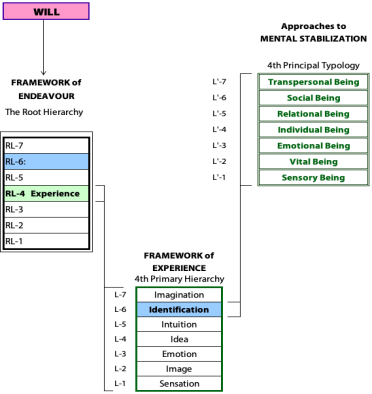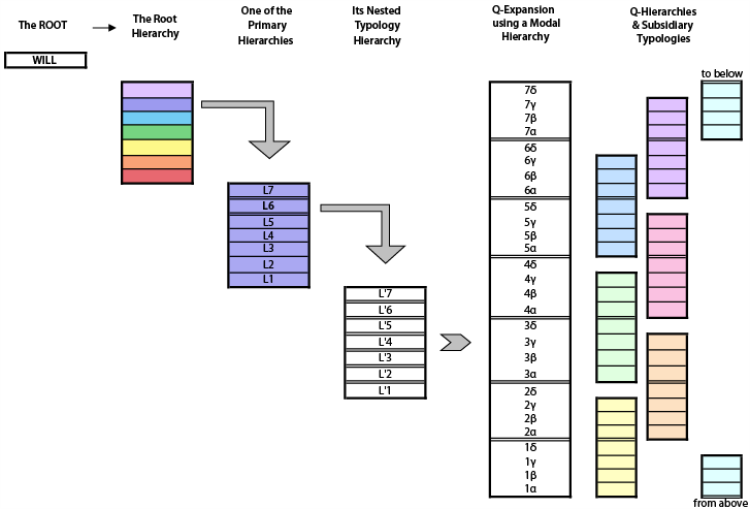THEE Typologies
Unusual Hierarchies
THEE Typologies are hierarchies formally, but they are not holistic because the Types do not imply each other. Ordering is not obvious, and, superficially, there is no obvious reason why additional Types might not exist. More than one ordering can be envisaged in some cases, and the taxonomically correct order is not obvious. Knowing the correct order enables derivation of further taxonomic frameworks.
Principal Typologies are the source of the control complex in their Domain and have received the most attention. Their Types are complex systems that determine the mindset or approach that we take to issues relevant to the originating Primary Hierarchy. More in the next Topic.
Typologies exist in four or five distinct forms within the Taxonomy. Numbers in brackets show how many are currently discovered or provisionally assumed. Click to go directly.
- Root Typology (1)
- Principal Typologies (7)
- Subsidiary or Q-Typologies (49)
- Tertiary Typologies (7)
There is possibly also a Quaternary Hierarchy/Typology.

Root Typology
The Root Typology, like the Root Hierarchy, has unusual features.
It contains apparently incompatible Types, although the degree of incompatibility is not certain at this stage. For example, it proved possible to use the ordering to develop a Tree of Good and Evil that exists universally, at least, in the imagination.
It seems that this Typology is personal rather than organizational or social. It determines 7 different ways to find , named . The appears as an over-arching orientation that governs a person's choices over their lifetime. Read more .
It does not seem that this Root Typology has a Style Hierarchy that permits a Q-expansion because something akin to this appears to occur in the Root Hierarchy instead.
The 6th Root Type, , contains a further nested Tertiary Hierarchy (Typology), which is holistic. This is similar to the finding in the . See Ch.8 in Working with Values![]() .
.
For Tertiary Typologies, see below.
Principal Typologies

The Principal Typologies are Secondary Hierarchies nested within the 6th Level of Primary Hierarchies , as illustrated at right for . These Types are identity-defining methods for handling situations and have overt controlling power, both socially and psychologically i.e.:
• as a doctrine ruling a social group
• as a mentality ruling a person.
The Principal Typology Hierarchy has Levels that are incompatible and incommensurable because of conflicting assumptions. This means that only one Type may be used in any particular situation, and none is «the best» in any absolute sense—despite claims to the contrary by adherents. All Types appear to be necessary and universally present. All define methods that are commonly required within relevant group situations e.g. in an organization or community.
The Type is an entity that seems to be constructed through «assigning primacy» to the corresponding Level in the
Primary Hierarchy. That is the current basis for ordering:
- organises the operation of
by focusing on & valuing primarily; - organises the operation of
by focusing on & valuing primarily; - organises the operation of
by focusing on & valuing primarily;
and so on till …
- organises the operation of
by focusing on & valuing primarily.
- In : —Methods for Making Decisions
- In : —Methods for Research
- In : —Methods for (i.e. creating order in reality)
- In : —Methods for
- In : —Methods for
- In : —Methods for
- In : —Methods for
Reflective individuals articulate their preferred Type with care, so as to provide a coherent explanation of its worth and superiority. This articulation is called «an approach» within THEE. The approach eventually enters textbooks used to indoctrinate newcomers to the field.
The approach may be referred to as a doctrine, ideology, paradigm, theory or simply a distinct perspective. Philosophical and scientific debates take place between proponents of the various approaches within a domain. However, in the nature of things, debates are tribal and cannot lead to any resolution. As with all value-system rivalries, the best to hope for is peaceful co-existence.
The same Type can be independently articulated for diverse fields, domains or disciplines with those involved remaining unaware of any commonality.
There are often efforts by socially dominant ideologies to restrict funding or employment of others with different ideologies/mentalities: an example can be found in a paper I published in Social Science & Medicine (1982).
Subsidiary Typologies (Q-Typologies)
Subsidiary Typologies form when Principal Typologies are differentiated by a 4-Level Style Hierarchy (formerly called a Modal Hierarchy) that contains distinct and progressive «styles of operating». The result is 28 Levels/Types (i.e. 7 Levels x 4 styles). This is called a Q-expansion, and it allows a clustering of Subsidiary Types into overlapping Q-domains with Q-Hierarchies, Q-Typologies and Q-Spirals.
![]() Click for diagram.
Click for diagram.
Better viewing: Use browser zoom if needed.
There are 49 of these Subsidiary Typologies, because there are 7 Principal Typologies and each generates 7 Subsidiary Typologies.
- 7 ways to
- 7 ways to
- 7 ways to
- 7 ways to
- 7 ways to
- 7 ways to
- 7 ways to
Note: Names in the above list are provisional.
Tertiary Typologies

Relatively little is known about these Typologies. The current conjectures are as follows:
- The Root Domainof has a holistic Tertiary Hierarchy (), which is a Typology of humanity-based rules called nested within in the .
See more here. - has a holistic Tertiary Hierarchy (), which is a Typology of society-based nested within .
See Ch. 8 in Working with Values. It is possible that there is a Quaternary Typology-Hierarchy nested within (i.e. the rule which is a ). It would deal with different theories about the nature of laws (i.e. jurisprudence).
- All remaining Primary Hierarchies are presumed to have a Tertiary Hierarchy that is a Typology, but whether they are uniformly holistic is not known.
For example: In the Framework of , generates a Tertiary Hierarchy whose Types/Levels are the of a society. These institutions determine much of our functioning as social beings. This structure may be holistic because the Levels seem to affect each other. No Quaternary Hierarchy has been identified to date within the .
- More on mentalities and approaches.
Originally posted: August 2009; Last updated 24-Jan-2014.
